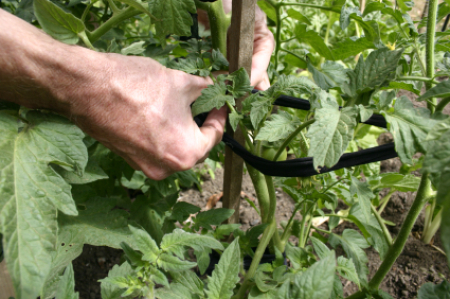
Staking garden plants is an important technique for keeping plants healthy and looking their best. There may be a number of different methods to staking plants, but there are really only two rules: stake plants early and try to be discreet.
Plants can grow surprisingly fast. If you don't stake them early, it can be difficult to get supports in place when your plants really start to take off. Not only that, but once the dreaded flop-over happens, it can be nearly impossible to stake plants in a way that looks natural.
Stake plants before they reach half of their mature height. This provides support before the plant is likely to need it and allows the plant to grow over its support and hide it from view.
Choose supports that are as inconspicuous as possible. Insert stakes behind or as close as possible to the stems so that as the plant grows, the foliage will hide the supports. Choose stake colors and ties that will blend in with the foliage of the plants.
When it comes to staking your vegetables, practicality always trumps appearances. Staking heavy bearers like tomatoes, peppers, and beans will make your job easier when it's time to harvest. Staking maximizes space, increases yields, and keeps produce off the ground where it is less like to fall prey to soil borne diseases. Use the tallest, sturdiest stakes and cages you can find and fasten plants to supports using bands from old pantyhose or strips torn from fabric.
Twiggy Brush: Push twig-sized branches into the ground next to your plants. The tops of the twigs can then be bent over and interlaced or tied together to form a lattice through which the plants will grow. As the plants grow through the tops and sides of the framework, they will eventually hide the twigs. This method works well for plants like coreopsis, and baby's-breath.
Cat's Cradle: Another effective means of supporting clumps of plants is to form a cat's cradle made from canes and string. Push the canes into the soil in-between and around the clumps of plants that need to be supported, and then weave the string in a random pattern between the canes to create a "cradle" of support. Trim off the tops of the canes to a height which hides them below the growing plants.
Individual plants can be staked using single canes made from rot-resistant wood or metal. If possible, place the cane behind the stem to make it less obvious. In most cases, the cane doesn't need to be as tall as the entire plant (with the exception of delphiniums). Supporting the lower half or two-thirds of the stem provides ample support while still allowing the top of the plant to move naturally. Sink the stake firmly near the stem when plant is 6 to 8 inches high. As the plant grows, add loose ties every 8 to 10 inches as needed.
Note: It's can be easy to poke yourself in the eye with a garden stake, especially one you've tried to camouflage, while bending over to admire your lovely plants. A good way to avoid this is to cover the tops with pieces of sponge or cork, old tennis balls, or small pieces of modeling clay. Better safe than sorry!
Ideally, plant ties need to be sturdy and weatherproof, yet soft enough so to prevent injury to the plant. Good materials for ties include bands cut from nylon stocking, strips of cloth from old bath towels or t-shirts, or flexible, foam covered wire.
Many garden stores also sell rolls of green Velcro made specifically for staking plants. The Velcro works great because it holds the stems firmly in place, it can be adjusted as plants grow, and the green color blends in easily with plant foliage.
When tying stems to supports, but sure not to tie them too tightly. Allow for some movement caused by the wind. This not only looks more natural, but it also helps the plants develop thicker, stronger stems.
How do you stake your garden plants?

About The Author: Ellen Brown is an environmental writer and photographer and the owner of Sustainable Media, an environmental media company that specializes in helping businesses and organizations promote eco-friendly products and services. Contact her on the web at http://www.sustainable-media.com
Add your voice! Click below to comment. ThriftyFun is powered by your wisdom!
You sound knowledgeable so I'm going to ask a question. I've asked other people, and also posted my question but got mostly idiotic or sarcastic replies. We planted a 3' tall dogwood last year (btw we are in Zone 8, southeastern NC) and a Bradford pear tree the same day. The Bradford pear is doing great. Growing tall and straight and even flowered beautifully this year, and now is leafed out gorgeous.
My problem is the dogwood. It insists on leaning one direction (away from the sun). There is nothing that could block it (middle of the yard), we've had some winds this year but not so much last year and it's been there a year now. I have it staked really well, and am constantly checking to make sure the stakes are still tight. Now that the trunk can't lean due to the stakes, the branches are reaching that direction.
Like I said the winds haven't bothered the other trees around here both large and small, and it's leaning away from the sun!
Any suggestions would be appreciated.
Add your voice! Click below to comment. ThriftyFun is powered by your wisdom!